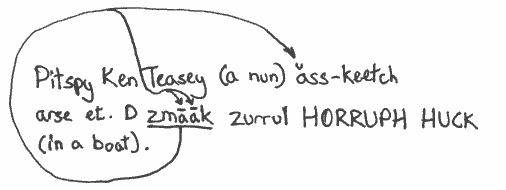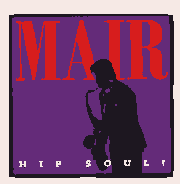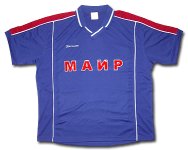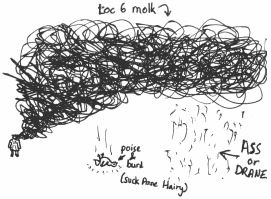Contact me
Pitspeak
This page is a work in progress, not yet a definitive
guide to Pitspeak.
Pitspeak is the term for the creative use of misspellings, homophones, abuses of
phonetic conventions, words from different languages, symbols, pictures, cryptic references,
etc. to put together a sequence of sounds which corresponds to a standard English (or other
language) sentence, but looks like gibberish, word salad, or in extreme cases a comprehensible
but completely variant meaning. Often, a person may read a sentence of Pitspeak aloud and completely
fail to understand what he has just said, even though others hearing it can understand it
easily. It is in effect a kind of cryptography where the encryption and decryption are
carried out by the human brain in real time, with the security provided by the obscurity
of the algorithm - much like the use of an obscure language would be, as in the case of the
Navajo code talkers of WW2. The
security may be pretty ropy but it is enough to make the more paranoid and repressive
type of government ban the sending of postcards in Pitspeak. In practical terms it can be
remarkably effective as the apparent meaning, or shreds of meaning, of the Pitspeak
provides a high degree of misdirection that tends to prevent the would-be cracker from
seeing the wood for the trees, and it has the ease-of-use advantage of a normal
language. Various more or less bizarre conventions exist which can be used to further
enhance the incomprehensibility to the point where it is possible to speak it out loud
without it sounding like its true meaning, but said meaning can nevertheless be
discerned by another skilled in the art. It is easy to learn, having undergone much
development both during boring times as a means to alleviate the boredom, and during
drunken times at the pub. It is useful, entertaining and broadens the mind and frees
the thinking.
The name "Pitspeak" is derived from the well-known behaviour of apes in scratching their
armpits. For this reason an icon of a grinning monkey has been used to provide
translations of Pitspeak examples in case you can't work them out. The translation is
concealed in the TITLE attribute of the image. Hover the cursor over the monkey to see
the translation. This is the "Ask the Monkey"(TM) feature.
Variants of Pitspeak have been known for a long time and used primarily for purposes of
humour. Many a generation of schoolboys have afforded themselves some light relief from
the tedium of a Latin lesson by such doggerels as:
 Caesar adsum jam forte
Caesar adsum jam forte
Brutus aderat
Caesar sic in omnibus
Brutus sic in at
To translate this as "I, Caesar, am here now by chance, Brutus was here, Caesar thus
in all things, Brutus thus in but" would be to miss the point, but it corresponds to
the reaction of the majority of people when presented with an example of Pitspeak of the
cryptic-communication variety:
 DIZZER, spits pique. Sink red double leader for Cult 2; one dust hand.
DIZZER, spits pique. Sink red double leader for Cult 2; one dust hand.
Here, the nonsense meaning, instead of being concealed behind the barrier of a different
language, is out in plain view, and it tends to put people off. It looks like it could be
a quotation from some surreal military thriller. But with a bit of
massaging of the syllables - a good method is to read it in the voice stereotypically
associated with the stereotypical stupid person for whom "duh" is a major linguistic feat,
preferably while drunk - and enough repetition, with punctuation ignored, its true meaning
becomes apparent:
This is Pitspeak. 'S incredibly difficult to understand.
Already we have illustrated some of the principles of Pitspeak. Completely made-up
words are present. Punctuation bears little resemblance to the plaintext version, and
is mainly placed so as to make it look good. Capitalisation is used in a similar
way. Words are selected, or made up, for their sound, and the breaks between words
mainly fail to correspond with the plaintext. Syllables are squidged a bit to make
them fit - the "Th" of "This" becoming "D" is a particularly common bit of squidging;
squidging may be based on common non-standard-English pronunciations, particularly
those used by London/Essex accents which are stereotypically associated with low
levels of intelligence and literacy; it may consist of changing a vowel sound, often
quite radically, as vowels have little influence on the comprehensibility of a
word; or it may just be some random inaccuracy which looks good.
 Dutter hubble (whip hits P) kizzit, SRAAAAGH VURRARD tud hoop-ropper LEER NUN
ass-keetch arse et. Darrain heed zush WHORE TMAAAAGH (cove or writ).
Dutter hubble (whip hits P) kizzit, SRAAAAGH VURRARD tud hoop-ropper LEER NUN
ass-keetch arse et. Darrain heed zush WHORE TMAAAAGH (cove or writ).
The limitations of an ASCII charset tend to make it difficult to do proper
Pitspeak. In the above example, the "a" of "ass" should carry a diacritical
mark to indicate that the intended pronunciation is short, as in the English
word for "donkey", not long as in the American word for "arse". My keyboard
doesn't have one of those, nor does it have the corresponding "long" mark,
accents, cidillas, umlauts or any of that shit. I have to piss around looking
stuff up in a UTF-8 charset table and typing in &#c0de;s, which is an arse.
 Dutter hubble (whip hits P) kizzit, SRAAAAGH VURRARD tud hoop-ropper LEER NUN
ăss-keetch arse et. Duty or fate (fur shin) zull horror FORK IN A BOAT.
Dutter hubble (whip hits P) kizzit, SRAAAAGH VURRARD tud hoop-ropper LEER NUN
ăss-keetch arse et. Duty or fate (fur shin) zull horror FORK IN A BOAT.
That's better, and it also illustrates a typical example of vowel squidging - "bout" has
become "boat". But the original, erroneous version also illustrates another
character-set-based limitation. There should be an arrow leading from the
word "Darrain" pointing to the "a" of "ass". It doesn't illustrate it very
well, because if I could draw an arrow, I could draw diacritical marks. So let's
have another example:


Besides illustrating the style of reference arrows in Pitspeak, this also
illustrates more generally how it should be written - in separate letters
of basic and unadorned style. Definitely not in joined-up.
Perhaps now is a good time to introduce some more conventions of Pitspeak. Because
the word breaks of Pitspeak do not line up with the plaintext word breaks, it is common
to get stuck at the beginning or end of a block with a beginning or end syllable that is
difficult to fit neatly into the Pitspeak. To alleviate this problem, filler syllables
are added. At the beginning of a block, useful fillers can be "but", "it's" or "but it's",
among others; at the end, "isn't it" (usually as "innit"), "eh?" and "innit eh?" are
useful. "Eh?" ("ay?") may be repeated, in the manner of the
Monty Python "nudge, nudge" sketch.
 Bristle-lorry's ear hūĭssumph HILL (a SILLY BULL) zinner tay?
Bristle-lorry's ear hūĭssumph HILL (a SILLY BULL) zinner tay?
This also illustrates the use of the combination "hūĭ" to represent the
"wi" at the beginning of words such as "with".
A couple of end-filler constructions have a certain iconic status in Pitspeak. Terminal "r"
may become grossly elongated into a sequence of guttural syllables which may range from a
simple "rgr" to a lengthy stream of grotesque nonsense:
 "Yuckung Errol-Oak (a moat of honour)" - LOLO DURGR.
"Yuckung Errol-Oak (a moat of honour)" - LOLO DURGR.
Note that it is laid out to look as if it was a quotation from someone called Lolo Durgr.
This is because it is cool to do stuff like that.
 Yuckud gherrer ("gnŭvurrunon") hūĭvvle HONG GUT (ray lurgrgrghrghrghrukgukghrrr
GhrGGGhhrgrukgrukgahueygruggukgrughhgghghhgrrrghrrrr).
Yuckud gherrer ("gnŭvurrunon") hūĭvvle HONG GUT (ray lurgrgrghrghrghrukgukghrrr
GhrGGGhhrgrukgrukgahueygruggukgrughhgghghhgrrrghrrrr).
(Silent "g"s at the beginning of words are common, as are silent "h"s after
pronounced "g"s.)
Similar constructions can be applied to other terminal syllables:
 Hūĭvver gnupht rail (or shoe) cadaver GNOLL TRAY nond hailghrghrghailghairhhggghghrrr.
Hūĭvver gnupht rail (or shoe) cadaver GNOLL TRAY nond hailghrghrghailghairhhggghghrrr.
The final word is more briefly written as "hair". Note also that the "h" has
been dropped from "whole", and the preceding "a" changed to "an" accordingly.
 Brim height bēăk (CESS of LEAL HONGHUEHUEGHUEGHUEYGAHUEYGHRUKGUKGAHUEYGRUGHUEGHHUE).
Brim height bēăk (CESS of LEAL HONGHUEHUEGHUEGHUEYGAHUEYGHRUKGUKGAHUEYGRUGHUEGHHUE).
Similarly, the final word here could be "hong". It wouldn't look so good though. The
"ē" and "ă" in "bēăk" indicate that the two vowels should
be pronounced separately, with the given values, so that although the word looks like
it refers to an avian mandible it doesn't sound like that.
Such enormously long terminators are best used sparingly, but you should always make
an effort to use one every now and then. It is more common to use a somewhat shorter one:
 A gnirrud may KLĀĀD ĢRHUTTHUE cinder OADDHUE.
A gnirrud may KLĀĀD ĢRHUTTHUE cinder OADDHUE.
Note that a "G" with a cedilla, "Ģ", is used to indicate that it should be
pronounced like a "J" despite there being no "e" or "i" following it.
The iconic status of grotesque guttural terminators is as nothing compared to the exalted
status of "mair". "Mair" is extremely useful for filling those awkward gaps at the end of
a block. (It should not be overused though; to have every block terminated with "mair" is
considered bad form. The following example, with two consecutive "mair"-terminated blocks,
is pushing the boundaries a bit:)
 Dub high (Khazad 80) tmair. DEER HUT zadavva mopht airb HIKE zmair.
Dub high (Khazad 80) tmair. DEER HUT zadavva mopht airb HIKE zmair.
The "Ask the Monkey"(TM) translation of the above should make it clear why
excessive use of "mair" is bad form. "Mair" is derived from "mate". You wouldn't say
"mate" at the end of every sentence in conversation, so you don't in Pitspeak. It is OK,
however, to repeat it several times at the beginning of a piece of Pitspeak, as you might
call it repeatedly when trying to attract someone's attention. You also use it to begin
letters. None of this poncy "Dear Sir" shit and wondering whether "J. Smith" is actually
Jane. A letter in Pitspeak, whether it is to a tramp or the Queen, begins with the salutation:
 Brome air!
Brome air!
As you will appreciate from your studies so far, it is entirely a concatenation of filler
constructions, so you wouldn't expect it to make a lot of sense. It's not so bad if you
ignore the "but".
The word "Mair" crops up occasionally in everyday usage, most commonly as someone's name -
it is not a very common name but it does exist. A Pitspeaker, on encountering something
like a signwritten van or premises belonging to a family surnamed Mair, or
this Welsh lake, will think it's the best thing he's seen all day, and will take photos
of it and send copies to all his friends. Here is some cool Mair stuff:






To return, for a while, to the difficulties of writing Pitspeak using current computer technology,
I feel it is time to introduce some of the "rebus" aspects of Pitspeak. "Rebus" has its normal
meaning in this context, the use of little pictures in place of text to represent words or
syllables. So we can write things like this:

|
Arthur |
 |
honey-pits |
 |
stup HICK CHURGRGRSZSZSZ. |
This (slightly contrived) example serves to illustrate not only the use of rebus methods
but to point out that, Pitspeak being what it is, they are not entirely straightforward.
In this example, one needs to know a bit about locomotives and the slang pertaining to
them. A Class 47 locomotive has a TOPS
number in the range 47xxx, a flat-fronted body, and six axles, and is known as a "Duff".
A Class 45 locomotive has a TOPS number in the range 45xxx, a body with stubby nose ends,
and eight axles, and is known as a "Peak". So the non-graphical representation of the above
example would be
 Arthur Duff honey-pits Peak stup HICK CHURGRGRSZSZSZ.
Arthur Duff honey-pits Peak stup HICK CHURGRGRSZSZSZ.
Those particular locomotives are extremely useful, especially the Class 47, as the syllable
"Duff" is quite common. Of course, there is no requirement to use the particular TOPS numbers
quoted in the example, and in a passage of Pitspeak which uses the "Duff" rebus many times it
is good to ring the changes; but note that the numbers should be examples which have been
allocated to real locomotives. So 47106, 47484, 47276 are all acceptable, but 47921 is not.
If you want to be a clever arse you can use pre-TOPS D-series numbers but one generally
does not.
Other rebus icons peculiar to Pitspeak include certain little cartoon characters which are not
found outside of Pitspeak. Meet Yosser:
 Dizzer soul JOSS:
Dizzer soul JOSS:  Ease goph HAISHER LAIR mair.
Ease goph HAISHER LAIR mair.
 Iossuz FARRAH KNEES ghorral HARD ĢBEL (haem hair). Butcher Khan, see Darren Dispik.
Iossuz FARRAH KNEES ghorral HARD ĢBEL (haem hair). Butcher Khan, see Darren Dispik.
Old Yoss is quite a popular character, but since "Yoss" or "Yosser" are not usually
particularly useful sounds to use in assembling some Pitspeak, he doesn't often appear
in the text. He's more likely to make a cameo appearance in the margin at a point where
the main text has mentioned obesity or facial hair. The cartoon image is usually limited
to his face because the
paper's not big enough to get the belly in as well. He is also referred to on such
occasions as when one describes a diagram of atoms in a hexagonal close-packed
crystal structure as looking like an X-ray of old Yosser's belly after he's been
eating ball bearings.
Here is another character who also doesn't appear in the text very often, though for a
different reason...
 Ear suppik churrer FOAM (Fourier):
Ear suppik churrer FOAM (Fourier):

 |
toc 6 molk |
 |
poise & burd (suck Anne Hairy) |
 |
ASS or DRANE |
You can probably guess why he doesn't put in an appearance that often, despite "Ohm" being
quite a useful sound - his picture is so complicated that it requires extra little captions,
it takes quite a long time to draw and uses up quite a lot of paper. It is therefore more
common to represent "Ohm" with "Ω", the standard abbreviation for the unit of resistance.
As you can see, Ohm is a stunted midget who puffs out quite
disproportionately large clouds of smoke, sufficient to gas passing birds and give
rise to forest-destroying precipitation. The bird illustrated is a canary both in
reference to the use of canaries to detect toxic gases in mines, and to allow the
caption for it to look like something rude; it also serves to give the picture scale
and emphasise Ohm's diminutive stature (their relative sizes are drawn to scale).
Ohm's skin is brown - from nicotine, not from
melanin - and he wears a lab coat, but such details are rarely discernible due to the
typical small size of the picture. The cloud of smoke is not to scale due to practical
limitations; a true representation would have it billowing out of your computer
screen, filling your house, leaking out of the windows and obscuring the street for three
houses either side of you beneath a dense toxic fug.
The appearances of Ohm and Yosser are standardised, ie. you always draw them as in the
examples, as you would if you were drawing Donald Duck or whatever. Now we are going to
meet another character who tends not to look the same every time, partly because again he
is very rarely drawn and partly because he is concocted from an assemblage of
stereotypes rather than being drawn from life as Yosser and Ohm are.
While his appearance varies, his enormous ears are a required feature, as are the apron,
the rolled-up trouser leg and any other stereotypically masonic items you feel like
putting in. His asymmetrical body shape is not a required feature, it's just that I'm
crap at drawing. But he is more usually represented in a purely textual form, mostly
in a cryptic fashion, as the "auditory orifice mason", or "genuine auditory orifice
mason" for added emphasis.
A further feature of Pitspeak is the square bracket element. Text inside square brackets
[] is not read, but evaluated, and the result of the evaluation is then read. This
sounds a bit weird, so let me illustrate with a simple example first:
 A few whirred [Fe] dusk [iodine]? Sprit [auditory orifice mason].
A few whirred [Fe] dusk [iodine]? Sprit [auditory orifice mason].
No doubt you're now thinking "But he said simple..." :-) Well, it is really. The
"auditory orifice mason" bit was explained in the paragraph above. The other bits are
basic chemistry. The first square bracket element is evaluated by noting that "Fe" is the
chemical symbol for iron, and the second is the same thing reversed, ie. the chemical
symbol for iodine is "I". So the whole thing evaluates to:
 A few whirred iron dusk I ? Sprit ear mason.
A few whirred iron dusk I ? Sprit ear mason.
which is fairly basic Pitspeak.
Square brackets are a bit clumsy when speaking Pitspeak. To speak the above you have to say
"A few whirred, Fe in square brackets, dusk, iodine in square brackets, sprit,
open square brackets, auditory orifice mason, close square brackets", or something
along those lines. Rarely, it is possible to indicate the presence of square brackets
by intonation and/or a suitable pause, but the majority of the time it is necessary
to denote them explicitly to avoid ambiguity. This is something of a pain in the arse,
but it does mean that non-Pitspeaking eavesdroppers will have even less of a fucking
clue what you're on about than with non-square-bracket-using Pitspeak. It's no
problem when writing though, and it can help compensate for the limitations of an
ASCII charset.
Let's have another one:
 Spidey, a lump-arse, and "sprodge"? Heck, Tmair! Ummer [Fireblade
with every other atom removed] fit.
Spidey, a lump-arse, and "sprodge"? Heck, Tmair! Ummer [Fireblade
with every other atom removed] fit.
It is probably the case that removing every other atom from a Fireblade, if
carried out rigorously, would leave you with a porous, weak structure with a
propensity to engage in strange chemical reactions and possibly some hitherto
undiscovered catalytic properties, but whatever form it takes, it's still
half a Honda.
Back to Pigeon's Nest
Be kind to pigeons

 Caesar adsum jam forte
Caesar adsum jam forte DIZZER, spits pique. Sink red double leader for Cult 2; one dust hand.
DIZZER, spits pique. Sink red double leader for Cult 2; one dust hand.
 Dutter hubble (whip hits P) kizzit, SRAAAAGH VURRARD tud hoop-ropper LEER NUN
ass-keetch arse et. Darrain heed zush WHORE TMAAAAGH (cove or writ).
Dutter hubble (whip hits P) kizzit, SRAAAAGH VURRARD tud hoop-ropper LEER NUN
ass-keetch arse et. Darrain heed zush WHORE TMAAAAGH (cove or writ).
 Dutter hubble (whip hits P) kizzit, SRAAAAGH VURRARD tud hoop-ropper LEER NUN
ăss-keetch arse et. Duty or fate (fur shin) zull horror FORK IN A BOAT.
Dutter hubble (whip hits P) kizzit, SRAAAAGH VURRARD tud hoop-ropper LEER NUN
ăss-keetch arse et. Duty or fate (fur shin) zull horror FORK IN A BOAT.


 Bristle-lorry's ear hūĭssumph HILL (a SILLY BULL) zinner tay?
Bristle-lorry's ear hūĭssumph HILL (a SILLY BULL) zinner tay?
 "Yuckung Errol-Oak (a moat of honour)" - LOLO DURGR.
"Yuckung Errol-Oak (a moat of honour)" - LOLO DURGR.
 Yuckud gherrer ("gnŭvurrunon") hūĭvvle HONG GUT (ray lurgrgrghrghrghrukgukghrrr
GhrGGGhhrgrukgrukgahueygruggukgrughhgghghhgrrrghrrrr).
Yuckud gherrer ("gnŭvurrunon") hūĭvvle HONG GUT (ray lurgrgrghrghrghrukgukghrrr
GhrGGGhhrgrukgrukgahueygruggukgrughhgghghhgrrrghrrrr).
 Hūĭvver gnupht rail (or shoe) cadaver GNOLL TRAY nond hailghrghrghailghairhhggghghrrr.
Hūĭvver gnupht rail (or shoe) cadaver GNOLL TRAY nond hailghrghrghailghairhhggghghrrr.
 Brim height bēăk (CESS of LEAL HONGHUEHUEGHUEGHUEYGAHUEYGHRUKGUKGAHUEYGRUGHUEGHHUE).
Brim height bēăk (CESS of LEAL HONGHUEHUEGHUEGHUEYGAHUEYGHRUKGUKGAHUEYGRUGHUEGHHUE).
 A gnirrud may KLĀĀD ĢRHUTTHUE cinder OADDHUE.
A gnirrud may KLĀĀD ĢRHUTTHUE cinder OADDHUE.
 Dub high (Khazad 80) tmair. DEER HUT zadavva mopht airb HIKE zmair.
Dub high (Khazad 80) tmair. DEER HUT zadavva mopht airb HIKE zmair.
 Brome air!
Brome air!








 Ease goph HAISHER LAIR mair.
Ease goph HAISHER LAIR mair.

